Genre: Action/RPG Developer: Riot Publisher: Renovation Players: 1 Released: 1991
For a while, Renovation was practically a Genesis owner’s best friend. Even though they were gone before the Genesis was, there was a good selection of genres represented in what they published in the states. Among those titles, was an action RPG by the name of Exile, a kind of port/remake of the 1988 MSX title, XZR. Like a number of other games under the Renovation banner, it got some advertising via full page ads, but not for very long before it faded into the background as big-name titles saw release. So, the question is this… is Exile a treasured oasis in the desert, or more akin to an empty mirage? Read on.
Sadler, a man considered a great desert hero, has had his taste of war. Years earlier, he led a revolt against a great superpower that arose from the many conflicts that saw smaller countries being overtaken by larger ones. When this revolt ended, the desert again returned to the peace it had known before the superpower came to be. However, Sadler’s life is not yet devoid of war. Luciel, a rival country, has begun an attack on the land Sadler calls home… Exile. He knows what must be done, and so has come to a desert fortress in hopes of gathering troops to fight the coming army. And it is here that our hero’s quest… a quest that will take him to places unimagined… begins.
Exile is a game with two distinct visual appearances. The first is an overworld map, which has a rather clean and at times simple look. It initially comes of feeling like it’s more solid colors than anything, but a closer look reveals there are some details in the various objects and locales, as well as shading that ranges from simple (buildings, etc.), to more detailed (trees, etc.). The animation for the people walking around in this view is kept to the usual three main frames that we’ve seen in many RPGs of the era, and while the characters are a bit smaller than you might be used to seeing, they still have some shading and such to make them look descent. However, the game has a second mode of play, and this is where the visuals change.
When you’re in the side-scrolling action platformer mode, the graphics take a considerable jump up. Noticeably more shading, smoother animation on the characters and more little touches (like flickering torches and falling snow) help make the areas you fight in look better. The characters are larger as well, allowing for more detail to be present in their designs. The level layouts are pretty straight forward until you get about 2/3 of the way into the game (some tricky door mazes await), and there’s not a lot of visual depth in terms of parallax scrolling. There is some in spots, but generally the backgrounds nice looking, if flat. But, with a lot of locales being in dungeons and caves, that last part’s a little excusable. A final point about the graphics is that scattered throughout the game are cut scenes. They aren’t very long, or all that heavy with animation, but they look fine with some animation at times. So all in all, Exile looks pretty good for a 1991 game. Not great, and a bit unbalanced between the two mode types visually, but pretty good.
With sound, the game is a bit lacking in one sense… namely, the sound effects. There are some, but they’re relegated to the action scenes. There, you get the somewhat loud sound of your sword slashing, enemies dying, your character jumping, and so forth. While some are OK, others seem a bit odd (like the sound of jumping into the air, which would fit better as a landing sound), and it’s hard not to notice that there really aren’t that many effects in use. This goes double for the overworld, where the only real sound effect comes when people are talking, or you make a selection in a shop… which is the same sound used for both. Otherwise, the overworld is pretty much just music.
Speaking of which, the music in this game isn’t too bad. The compositions range from catchy to moody in feel, and generally stay above average in terms of quality. Many songs have a bit of a hip hop-like vibe to them with their beats, which seems a little out of place given the setting, but this is countered a bit by the music’s rather distinct feel thanks to the music engine used, the chosen instruments, and the compositions that offer a little Arabic and Oriental touch here and there to fit more with the game’s setting. While it’s true that the instruments chosen might not always be the most pleasant, none of them are gratingly obnoxious, making the music as a whole reasonably enjoyable.
When it comes to gameplay, Exile has much of what you’d expect with something that has RPG elements. The story unfolds as you talk to NPCs, and it’s not a half bad story. It doesn’t always make 100% sense thanks to some areas of the translation, but it’s got some depth to it beyond “save princess/world.” As the tale takes you from one locale to another, you’ll buy better weapons and armor from shops and pick up various items to help you out as well. You have a party of four to move around initially, but that party changes regularly as the game rolls on. You can save at any time when you’re on one of the overworld maps, you’ll level up as you gain experience from the enemies you kill, and all this adds up to having many familiar traits from the RPG genre. It’s when you fight though, that the game shifts to a different mode.
Rather than fighting in the turn-based style we all know so well, this game instead turns to the aforementioned action platforming. You can swing your sword, jump, slash in the air and slice downward, and it all works well thanks to solid controls. Not a lot at your disposal, I know, but you can also use magic to fight the enemies you’ll have to face, as well as recover a bit of health as you go up against them. And if you run low on magic points, you can also use the various items that are able to be purchased during the game that can give you back some health, or temporarily boost your attack and/or armor class.
“All right,” I hear you thinking, “what’s wrong with it?” To be honest, there aren’t many major things wrong with this game. The first problem that you’ll be facing is the dreaded “enemy respawn syndrome.” While it can come in handy for very easy leveling up in spots (which may be seen as a good or bad thing), it turns into a real pain when you’re low on health in a tough section, or trying to jump up onto the only small platform you can reach and keep getting hit by the same enemy that respawns over and over because you still kill it, only to fall a little too far and have it come right back. The other main issue is that the hit detection isn’t the best. It’s not broken, but when enemies are coming at you from above, the game seems to get really picky about what is and isn’t a hit at times, even though the crescent slash of your sword keeps touching that airborne enemy.
Those are the two main complaints to be made. However, even though the big problems are minimal, there are a good number of smaller ones. Leading the pack, is how you’ll come across some odd glitches in spots, both visually and aurally. Going from one stage to another makes the screen basically blink apart like the game’s replacing different sections in semi-rapid succession instead of the whole thing at once. It looks almost like something out of an old DOS game running on a slower computer. Sometimes it even happens when it’s only the small dialogue picture changing. At other times, a sound effect and/or menu coming up will change the sound of an instrument that’s playing. The drums or sometimes a backing instrument will become more muffled or stand out when it didn’t before. This is always fixed with another quick press of the menu button, but these kinds of bugs should have been caught and fixed.
Among other more minor complaints, is that there’s a lot of back tracking toward the end. The game goes along as a good clip until you get to one of the final lands, then you spend a greater amount of time going back and forth between temples, lands and so forth than anything else. It’s not horrendous, but considering the game was doing fine without the back tracking up to that point, was it really necessary? Along with that, is how this game’s dialogue is a bit odd at times. You’ll go for a stretch where everything reads all right, then you’ll get broadsided by a diatribe that’s unnecessarily long and written in a strange way in spots (like when Sadler comes out of the Ant Lion trap), or just doesn’t quite make sense (like when you fight the horseman). Not sure what was going on at the script meetings, but it’s something that makes you go “huh?”
Another little thing to be mentioned is that you really only control Sadler the entire time. What you buy is just for him, as you don’t use the other characters at all throughout the game. Some stay behind at times, others get kidnapped or replaced like what other RPGs do, but the other characters really don’t do anything except tag a long harmlessly (or uselessly, if you prefer). And finally, pay attention to what some NPCs have to say. I repeat… PAY ATTENTION! This game isn’t always very generous with clues about what you have to do (like with the Mandrel in the prison you’re trying to get someone out of), which can lead to some serious “what the hell do I do now?” moments. Even seemingly arbitrary comments wind up being important at times. Thankfully, the NPCs aren’t grotesquely numerous, but a little extra clarification would have been nice.
So, what can we say about Exile? Is it a great game? No. Is it a bad game? Again, no. The graphics and sound are above average on the whole, the story is unexpectedly involved, and though the action is pretty simplistic, it does keep you on your toes well enough. It doesn’t stumble and fall on its face, but it doesn’t really excel in any one area either. It simply rolls along with various little oddities that never break the game but are numerous enough to show that it could have used some extra translation tweaks and bug fixes. As a result, rather than bomb out completely or soar to greatness, Exile just kind of… goes along. It’s an under the radar type of game that if you give it chance, it’ll keep you entertained for four or five hours before it’s over but won’t likely become one of your favorites for the system.
SCORE: 6 out of 10

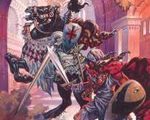
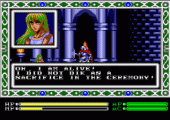
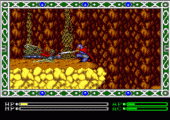
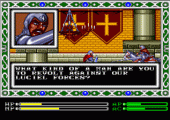
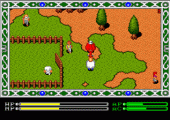
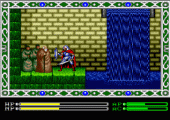
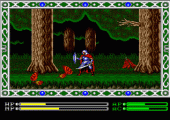
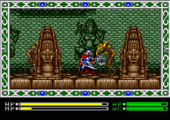
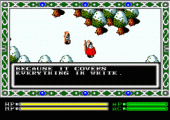
Recent Comments